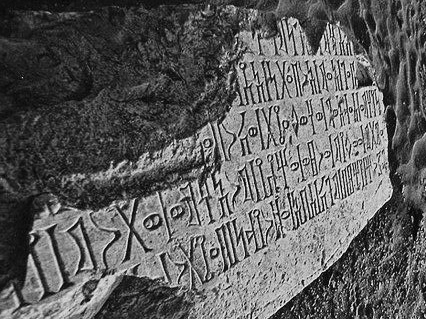Inscriptions represents various languages at different places and period of time. They were written in all languages like Prakrit, Pali, Sanskrit, Tamil, Telgu, etc. Most of them written in Brahmi script till 7th century A.D. afterthat, strong regional variations in script was seen.
On the basis of contents of inscriptions, they can be grouped as follows:
1. Administrative Inscriptions
2. Religious and Didactic Inscriptions
3. Eulogistic Inscriptions
4. Commercial Inscriptions
5. Magical Inscriptions
6. Donative Inscriptions
7. Commemorative Inscriptions
1. Administrative Inscriptions
These inscriptions give valuable information regarding the extent of the kingdom, administration, etc. Ashoka's edicts are a specimen of this group. The Junagadh rock inscription of Rudradaman I, Banskhera Copper plate inscription of Harsha, Sohgaura copper plate Inscription, are some other examples.
2. Religious and Didactic Inscriptions
These inscriptions give information about religious and moral matters of the time. Best speciem of this group of inscription is Ashoka's Edicts. Bhabru edict expresses Ashoka's faith in the Triratna of Buddhism. Rock edict X, XI and XII preached religious toleration, true charity and practicing Dhamma.
3. Eulogistic Inscriptions
These inscriptions give information about name and genealogy of the ruler, his military and political achievements, inter-state relations, the political ideas, his patronage and personal accomplishments. These inscriptions eulogise the achievements of kings and never speak of their defeats or weaknesses. So, they are very important from the political point of view. Ashoka's Edicts, Hathigumpha inscriptions of Kharavela of Kalinga and the Allahabad Pillar inscription of Samudragupta are some of best examples. The Aihole stone inscription (Karnataka) of the Chalukya king Pulakeshin II written by Ravikirti, Girnar Rock inscription of Rudradaman, Mandasaur stone pillars inscription of Yasodharman, Nasik cave inscription of Usavadata, Gwalior prasati of King Bhoja, are some other examples.
4. Commercial Inscriptions
These inscriptions provide us information of commercial and trade. Their specimens are to be found on the seals of the Indus Valley. They mostly used as stamp to stamping goods.
5. Magical Inscriptions
These inscriptions contains magical formulas on them and used as amulets. These group of inscriptions were found in Harrappan seals. These seals represents various animals, trees and deities.
Note: The Harappan inscriptions were written in Pictographic Script and has not been deciphered yet.
6. Donative Inscriptions
These inscriptions deals with donations of caves or buildings to monks, land and villages to monks and priests, money to educational institutions, monasteries and brahmans.
7. Commemorative Inscriptions
These inscriptions were the record events like birth, death or other important events. Some of inscriptions in this group contain poetic compositions and dramatic works; they are termed as literary inscriptions due to these properties. For example, Rummindei inscription (Nepal), Sarnath inscription (U.P.), Dhauli inscription (Odisha), Jaugada inscription (Odisha) of Ashoka, it mentions that a huge stone pillar was erected and huge stone wall was constructed at the birthplace of Buddha (many years after his coronation).
So, Epigraphy throws light on the life lived in the past, the nature of society and economy and the general state of life as a reliable information source.
Next Article:
2. Monuments
References
Also see:
1. Bharatvarsha
4. Literary Sources
6. Archaeology Dating Methods





